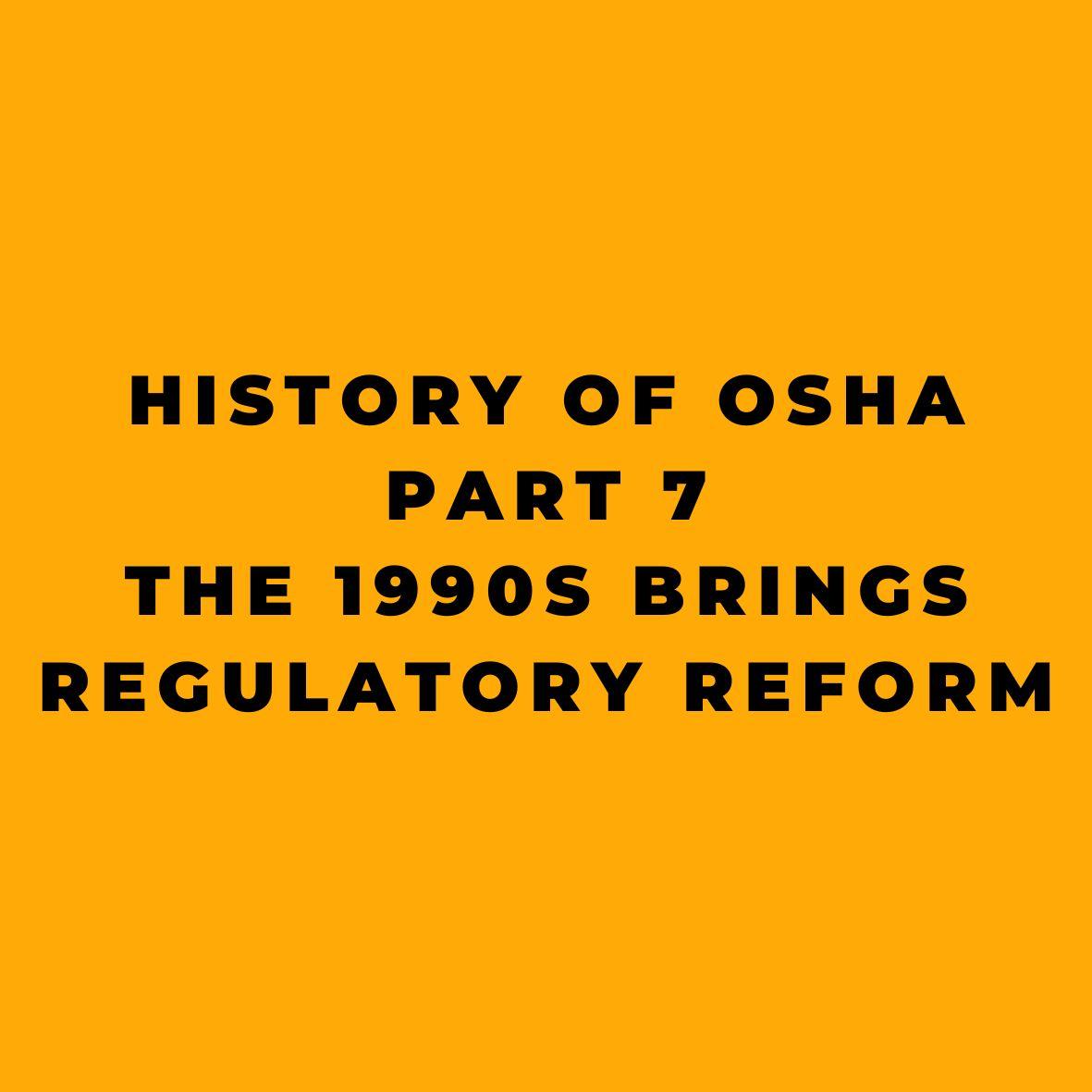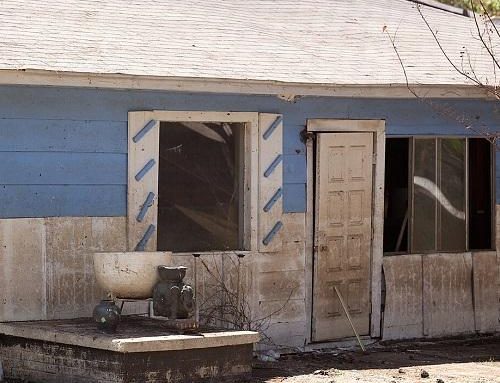Part 1, Part 2, Part 3, Part 4, Part 5, Part 6, Part 7, Part 8
The 1980s saw regulatory reform as the central theme of the federal government. With the beginning of the 1990s and a new presidential administration, the focus shifted to “reinvention.” In 1993, Secretary of Labor Robert Reich appointed Joseph Dear, former director of the Washington State Department of Labor and Industries, as OSHA Administrator with the mandate to “reinvent OSHA and make it more effective.”
To respond to the goals set forth by the Government Performance Results Act of 1993, Dear established a “National Reinvention Steering Team.” He laid the groundwork for a more cooperative regulatory approach, opening the rulemaking process to stakeholders affected by proposed standards. The goal was to achieve consensus on general principles, so comments during formal rulemaking would be more focused on technical aspects of the proposed rules.
To further enhance openness and collaboration, OSHA created the Steel Erection Negotiated Rulemaking Advisory Committee in 1995 under the Negotiated Rulemaking Act. The committee, comprising contractors, labor, and government representatives, was tasked with developing a standard agreeable to all parties. The first consensual proposed rule was released in 1997.
The 1990 Omnibus Budget Reconciliation Act dramatically increased OSHA penalties. Maximum penalties for violations rose seven-fold, and a minimum proposed penalty of $5,000 was imposed for willful violations. The maximum civil penalty became $70,000 for each willful or repeated violation, $7,000 for each serious or other-than-serious violation, and $7,000 for each violation of posting requirements and each day beyond a stated abatement date for failure to correct a violation.
These new penalty levels applied to citations issued for inspections that began after March 1, 1991. Proposed penalties peaked at nearly $96 million in FY 1994, fell to about $49 million in FY 1996, and then rose to the $60-$70 million range in subsequent years. The largest dollar impact was on willful violations, with average penalties ranging from $12,000 to $28,000 post-legislation. Penalties for serious, repeat, and failure to abate violations were about three to four times higher under the new law.
To prepare for a higher contest rate, regional offices met with their respective OSHA counsels to develop joint proposals for case development and handling. The aim was to limit the number of cases to be handled by the Regional Solicitor’s office, ensure that selected cases for litigation were fully developed and appropriately issued, maximize OSHA’s penalties’ deterrent impact, and expedite hazard abatement. These “treaties,” initially developed in 1991 and later revised in 1994, continue to guide OSHA’s working relationships with the Solicitor’s office and resulted in both parties working towards a common goal.
In response to criticism that OSHA was overly confrontational with employers, the agency began a reinvention process in the mid-1990s that included a “cooperative partnership” approach to achieving compliance with health and safety standards. This strategy, combined with traditional enforcement programs, offered penalty reductions and other incentives for employers who made a good faith effort to protect employees. The reinvention program aimed to meet an OSHA goal of reducing injuries and illnesses in 100,000 workplaces by 20 percent over five years, as outlined in OSHA’s Strategic Plan for Fiscal Years 1998-2002, required under the Government Performance and Results Act (GPRA) of 1993.
The Maine 200 program, which ran from 1993 through 1996, exemplified this approach. Using state workers’ compensation data, OSHA identified 200 employers in Maine with the highest number of injuries and offered them a chance to work in partnership with the agency or face increased enforcement. All but two employers chose the partnership. Participants in the program eliminated hazards at a rate 14 times greater than what would have been expected under the standard OSHA enforcement process, with over 70 percent reporting significant reductions in serious injuries.
The Maine 200 program received the 1995 Ford Foundation Innovations in American Government Award and a Hammer Award from Vice President Al Gore’s National Performance Review.
The Maine 200 program served as the foundation for the Cooperative Compliance Program (CCP). CCP was developed using data collected in the 1996 OSHA Data Initiative (ODI) from 80,000 employers in industries with high injury and illness rates. OSHA extended an offer of participation in the CCP to 12,250 of these employers with the highest rates. The premise of the program was that if an employer accepted the offer and joined the CCP with a commitment to develop a workplace safety and health program meeting certain guidelines, they would reduce their chance of a programmed safety and health enforcement inspection from 100 percent to 30 percent. Small employers (i.e., less than 100 employees) that requested special compliance assistance would reduce their inspection chances to 10 percent.
More than 87 percent of the employers offered this partnership program had accepted when, in February 1998, the U.S. Chamber of Commerce, National Association of Manufacturers, American Trucking Association, and the Food Marketing Institute filed a lawsuit in the U.S. Court of Appeals in Washington, D.C., to block the CCP’s implementation. They argued that OSHA did not follow proper procedures for rulemaking when instituting the program. In April 1999, the D.C. Circuit Court of Appeals ruled against OSHA.
While the CCP was on hold pending the court’s ruling, OSHA resumed traditional enforcement operations, using a plan that targeted 3,300 employers in 99 industries with injury or illness rates at or above the national average, based on injury and illness data collected through the ODI.
Following the D.C. Court of Appeals’ ruling, OSHA announced the Site-Specific Targeting Plan (SST). This program directed inspections of 2,200 high-hazard workplaces with the highest injury and illness rates, based on data collected in 1998 from approximately 80,000 employers as part of the ODI.
As the decade progressed, OSHA’s reinvention efforts continued to evolve, incorporating a more cooperative approach, engaging with stakeholders, and using data-driven strategies. These initiatives aimed to make OSHA more effective, collaborative, and focused on achieving its mission of improving workplace safety and health. The lessons learned from the 1990s have informed and influenced OSHA’s operations and strategies in subsequent years, continually shaping the agency’s efforts to protect workers and promote safe workplaces.
The government reinvention initiative has led OSHA to revise its Field Operations Manual (FOM), transforming it into the Field Inspection Reference Manual (FIRM). This change aimed to make the FIRM a more accessible and useful document, granting Compliance Safety and Health Officers (CSHOs) the ability to exercise professional judgment in their decision-making process.
To facilitate the transformation of the agency’s operations, OSHA established the National Reinvention Steering Team. This team, composed mostly of members on one-year rotations, served as an “ideas group” to develop recommendations and filter suggestions down to other teams. OSHA employees were surveyed to gather ideas and feedback, which were evaluated and implemented as appropriate.
In response to the enthusiasm for effective team-based initiatives, OSHA created Strategic and Rapid Response teams in each office. These teams underwent four to six weeks of training as part of the reinvention process. The training aimed to resolve long-standing personality clashes within the offices, a crucial element of team building.
The “Robo-CSHO” initiative aimed to equip compliance officers with technology and tools to increase their productivity. This initiative led to the use of video cameras to document violations in the field.
In January 1997, Assistant Secretary Joe Dear left the agency, and later that year, Charles Jeffress became the new Assistant Secretary for OSHA. Jeffress had previously served as North Carolina’s deputy labor secretary, overseeing the state’s OSHA program. He was credited with rebuilding the state’s job safety and health capacity after the tragic Imperial Foods Processing fire in 1991.
During the 1990s, OSHA issued a number of significant safety and health standards, despite criticism from multiple stakeholders. The agency began addressing new issues such as infectious diseases, indoor air quality, and ergonomics. New Congressional mandates, such as the Small Business Regulatory Enforcement Fairness Act (SBREFA) and Executive Order 12866 for Regulatory Planning and Review, impacted the rulemaking process with the intention of promulgating more robust standards and regulations.
Several major safety and construction standards were finalized during this time period, including rules for confined spaces, logging operations, and fall protection in construction. OSHA also completed work on several major health standards, such as the final standards for cadmium, lead in construction, hazardous chemicals in laboratories, methylene dianiline, 1,3-butadiene, and methylene chloride.
Among these comprehensive health standards was the landmark standard for bloodborne pathogens. This standard focused on the hepatitis B virus (HBV) and the human immunodeficiency virus (HIV). The nationwide concern over HIV and the AIDS epidemic in the U.S. played a strong role in promoting the promulgation of the final standard. This standard significantly influenced work practices and safety and health programs in the healthcare industry.
Another major rule from this decade was the final standard for respiratory protection. This rulemaking, which sought to update the 1972 standard, was controversial, particularly due to its requirements for annual fit testing. The standard’s broad coverage greatly influenced employee safety and health.
In addition to promulgating these final rules, a great deal of standards activity focused on revising standards in response to court challenges. For example, the formaldehyde and asbestos standards set in the late 1980s underwent judicial challenges that resulted in remands by the courts for certain sections of these rules. These remands led to further rulemaking activities, including lowering the permissible exposure limits (PELs) for formaldehyde and asbestos, adding medical removal protection for formaldehyde, and excluding non-asbestiform minerals from the asbestos standards.
In 1991, a major court decision resulted in a significant setback for OSHA. Two years prior, OSHA had revised its Air Contaminants standard to address the concern that existing Permissible Exposure Limits (PELs) – adopted in 1971 and based on health data from the 1960s and earlier – were outdated for many substances. Both organized labor and industry agreed on the need to update the standard; however, PELs for several chemicals were challenged in court.
In reviewing the challenge, the court ruled that the process OSHA used in revising the standard did not meet the legal requirements for establishing significant risk for each individual PEL. As a result, the court vacated the entire standard. Although the new standard had been enforced for two years, OSHA had to revoke the new PELs and revert to the original 1971 PELs. OSHA continued to seek ways to update its PELs, but the agency was compelled to maintain a substance-by-substance approach to standards development.
This setback highlighted the complexities of the regulatory landscape and the challenges faced by OSHA in ensuring workplace safety while adapting to changing conditions and emerging hazards. The 1990s were a period of growth and reinvention for the agency, and the lessons learned during this time laid the foundation for OSHA’s future initiatives.
The reinvention of OSHA in the 1990s, marked by the revision of the Field Operations Manual (FOM) and the establishment of the National Reinvention Steering Team, demonstrated the agency’s commitment to transforming its operations to better serve the American workforce. These changes, combined with the promulgation of significant safety and health standards, played a crucial role in shaping OSHA’s modern approach to workplace safety and health.
As OSHA moved forward, it continued to face new challenges and opportunities. Emerging issues such as the use of technology in the workplace, the rise of gig economy workers, and the increasing diversity of the American workforce required OSHA to adapt and innovate. The experiences and lessons from the 1990s reinvention efforts provided a strong foundation for the agency to build upon in the years to come.
Looking back, the 1990s were a pivotal time for OSHA. The agency underwent substantial changes in its operations and approach, learning from both successes and setbacks. The reinvention of OSHA during this time was not only a response to external pressures but also a recognition of the need for internal change and growth. This period of transformation has had a lasting impact on the way OSHA operates, shaping the agency’s vision and mission for the future.
The story of OSHA’s reinvention in the 1990s is one of resilience and adaptability. The agency’s willingness to embrace change, learn from its mistakes, and innovate has helped it navigate a complex regulatory landscape and better serve the American workforce. As we reflect on this period of transformation, we can appreciate the hard work and dedication of the many individuals who have contributed to OSHA’s ongoing mission to ensure safe and healthy working conditions for all workers in the United States.
Part 1, Part 2, Part 3, Part 4, Part 5, Part 6, Part 7, Part 8
Reference:
- U.S. Department of Labor. “Reflections on OSHA’s History.” Occupational Safety and Health Administration, January 2009, OSHA 3360.










